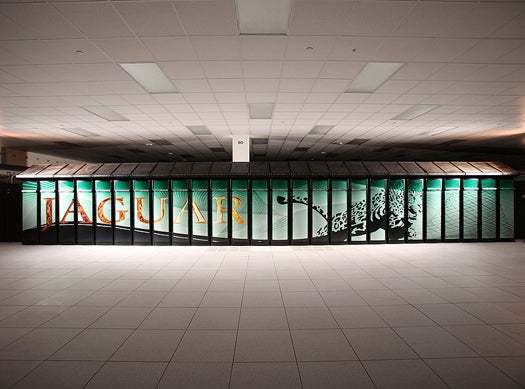Jaguar, What Are You Working on Today?
A word with the nation's biggest petascale supercomputer

Over the last week, we managed to get some of the nation’s biggest and baddest supercomputers to take a moment away from their gigabusy schedules and tell us what they were working on. They were happy to share.
Name: Jaguar
Ranking: 3 (an ongoing upgrade should make it no. 1 by 2013)
Vital Stats: System: Cray XT5-HE. Processor: AMD x86_64 Opteron Six Core 2600 MHz. There are 224,162 cores in there, producing 2.3 million billion calculations per second (petaflops). With a pending upgrade that number should be more like 300,000 cores, including a bunch of GPUs optimized for parallel computing problems. This is the world’s third-largest–soon-to-be largest once again–supercomputer. Oak Ridge National Labs’ world-beating platform works on everything from nuclear physics to clean energy science to nano-scale materials modeling.
So What Are You Working On Today?
• Calculating a water molecule’s adsorption energy and geometry on a sheet of graphene, which could greatly inform our understandings of both hydrogen storage in batteries and corrosion on surfaces.
• Defining the structure of atomic nuclei via research that could inform everything from nuclear fission and fusion to carbon-dating to nuclear physics on the whole.
• Modeling various industrial catalysts, the likes of which could boost industry in a range of sectors–including energy and pharmaceuticals–as well as advance clean energy production, storage, and transmission.
• Exploring battery chemistry, particularly as it pertains to rechargeable lithium-air batteries that could hold ten times the energy of lithium-ion batteries of the same weight (think better electric cars).
• Simulating new kinds of light water reactor technology that could extend the life of next-gen nuclear plants.
• Simulating diamond nanocrystals simply to better understand their properties, which could have impacts anywhere from chemical engineering to materials science.
• Working on the next big steps toward constructing ITER, the international experimental nuclear fusion reactor.
All that? Not bad for a day’s work! When Jaguar’s upgrade is complete in late 2012 or early 2013, it will jump from 2.3 petaflops to a peak performance somewhere between 10 and 20 petaflops (that’s 10-20 million billion calculations per second). No wonder, then, that ORNL will be renaming the supercomputer Titan.